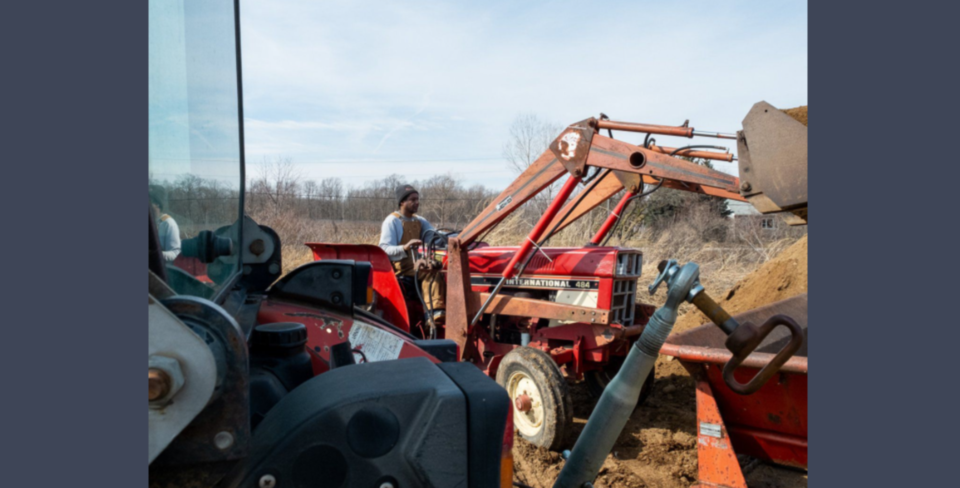Underneath the surface at Saunders Family Farm and Vineyard in Beamsville, there’s much more than meets eye.
As Anne-Marie Saunders pruned vines on a recent Wednesday, her brother, Leslie, manoeuvred a trailer, showering rows between long-standing grapevines with a mixture of duck manure and wood bedding.
Here, along with their certified-organic land and “biodynamic” principals, the Saunders practise regenerative agriculture.
The soil and plants flourish in symbiosis; below the surface is teeming with billions of wiggling micro-organisms devouring carbohydrates funnelled through roots below, then providing nutrients in return to plants above.
At its roots, regenerative agriculture is about humans getting out of the way of nature.
After the Saunders’ mother, Ivy, died from Parkinson’s, a disease linked to pesticides, coupled with a hit from the 2008 financial crisis, the family began making principled changes.
It was the beginning of less dependence on chemicals, and a shift in attitude toward being proactive and letting the land work for itself.
Out went the synthetic fungicides and pesticides, and on the vines went heavy coats of sulphur to combat Niagara's notorious struggle against mildew.
“One of the biggest things is really leaving the soil covered,” Leslie said.
Daikon radishes, oats and peas were all planted last year among the natural grasses and dandelions in alternating rows throughout their vineyard.
Cover cropping keeps soil cool while root systems allow for oxygenation and maintain soil structure, preventing water run-off and erosion.
“In the beginning to set the cycle is a learning curve,” admits Ann-Marie.
The Saunders’ vineyard is part of a multi-year soil health benchmark study with the Ecological Farmers Association of Ontario and the siblings do soil and sap analysis to help predict what the vines will need throughout the growing season.
“You’re wanting the plant to grab nutrients from the soil when they need it, not when we think they do,” Ann-Marie said.
In the future, they’ll also integrate more of their “compost tea” when fertilizing to encourage nutrient cycling (regeneration from decomposition) and to increase root excretions into the soil.
A little over 30 km away, the Saunders’ grapes are turned into wine by Ann Sperling, at Southbrook Vineyards in Niagara-on-the-Lake.
Southbrook, founded and owned by Bill and Marilyn Redelmeier, also practices regenerative farming, growing over 75 acres of grapes for their wines.
“Great wines come from vineyards that are carefully farmed,” Sperling said.
“If you consider a vineyard, it’s monoculture,” she said, “there’s a whole lot of the surface area of the vineyard that needs to be managed somehow.”
Like the Saunders’, Southbrook uses cover crops to encourage nutrient diversity in their soil, and to attract beneficial insects.
Manure from livestock at Linc Farms, situated on Southbrook’s land behind the vineyard, is brought over and used as fertilizer.
Each season, a variety of clovers, grasses, alfalfa, dandelions, legumes and henbit (to name some) dig their roots through the soil and bring fertility through nitrogen fixing and help to store CO2 into the ground via photosynthesis.
“Over time as the ecosystem becomes more sophisticated, we have to intervene less,” Sperling said.
It’s not that conventional farming practises are less sophisticated — some growers can use around 25 pesticides to combat a litany of threats, Sperling says — it’s that regenerative farming calls for a ground-up approach.
Starting with the soil has produced tangible results above it, in the thickness of their grape’s skins, Sperling said.
“Those thicker skins are the grapes' natural resistance,” she explained. They also help provide good tannin structure and colour for their wines.
Sperling finds satisfaction in working from the ground to improve what goes into the bottle.
“It’s also very humbling; it’s not all about me, it’s not all about control, it’s working with the seasons and growing conditions,” she said.
It may be a bigger challenge, but adjusting ultimately delivers in quality wines that are not only better in the glass, but also better for the land and the surrounding community.
- Jordan Snobelen, Local Journalism Initiative, Niagara This Week



